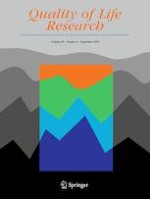14-05-2020
Identifying clinically meaningful severity categories for PROMIS pediatric measures of anxiety, mobility, fatigue, and depressive symptoms in juvenile idiopathic arthritis and childhood-onset systemic lupus erythematosus
Gepubliceerd in: Quality of Life Research | Uitgave 9/2020
Log in om toegang te krijgenAbstract
Purpose
A key limitation to widespread adoption of patient-reported outcome (PRO) measures is the lack of interpretability of scores. We aim to identify clinical severity thresholds to distinguish categories of no problems, mild, moderate, and severe along the PROMIS® Pediatric T-score metric for measures of anxiety, mobility, fatigue, and depressive symptoms for use in populations with juvenile idiopathic arthritis (JIA) and childhood-onset systemic lupus erythematosus (cSLE).
Methods
We used a modified standard setting methodology from educational testing to identify clinical severity thresholds (clinical cut scores). Using item response theory-based parameters from PROMIS item banks, we developed a series of clinical vignettes that represented different severity or ability levels along the PROMIS Pediatric T-score metric. In stakeholder workshops, participants worked individually and together to reach consensus on clinical cut scores. Median cut-score placements were taken when consensus was not reached. Focus groups were recorded and qualitative analysis was conducted to identify decision-making processes.
Results
Nine adolescents (age 13–17 years) with JIA (33% female) and their caregivers, five adolescents (age 14–16 years) with cSLE (100% female) and their caregivers, and 12 pediatric rheumatologists (75% female) participated in bookmarking workshops. Placement of thresholds for bookmarks was highly similar across stakeholder groups (differences from 0 to 5 points on the PROMIS t-score metric) for all but one bookmark placement.
Conclusion
This study resulted in clinical thresholds for severity categories for PROMIS Pediatric measures of anxiety, mobility, fatigue, and depressive symptoms, providing greater interpretability of scores in JIA and cSLE populations.
